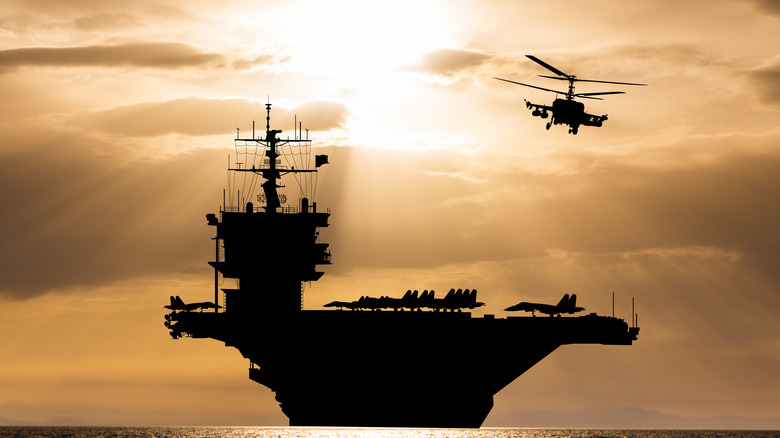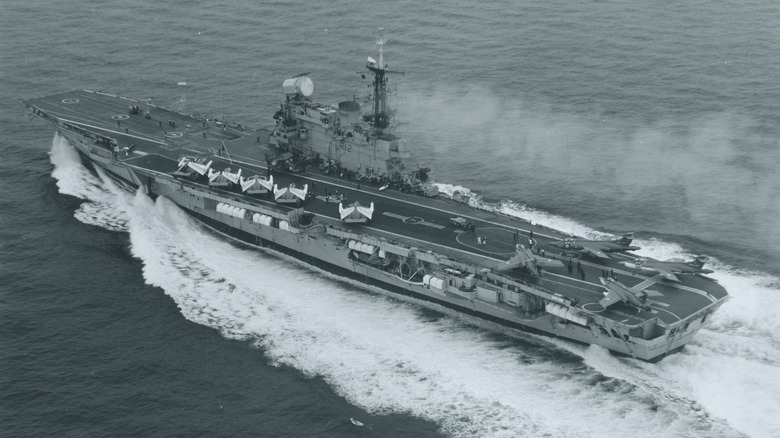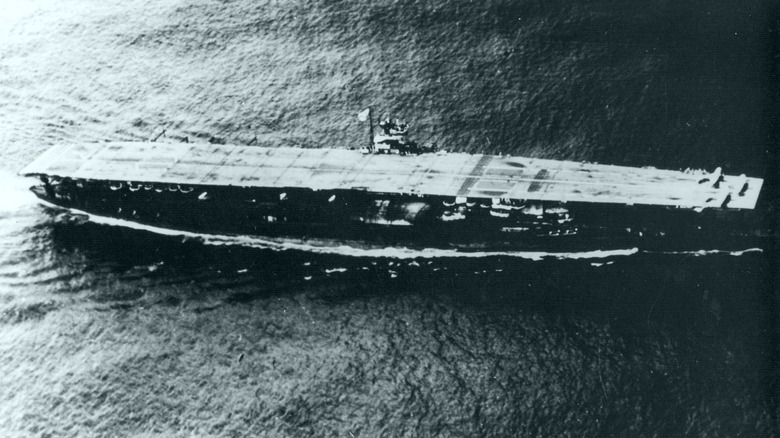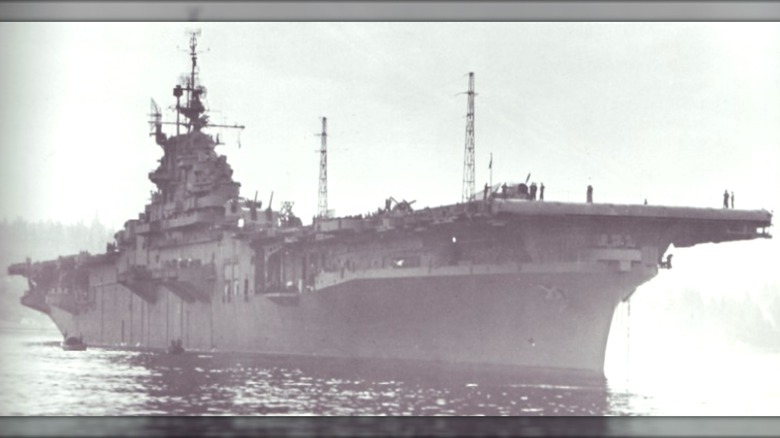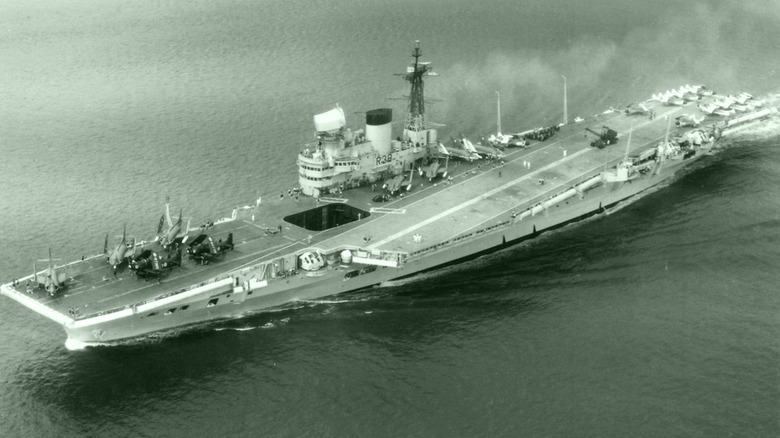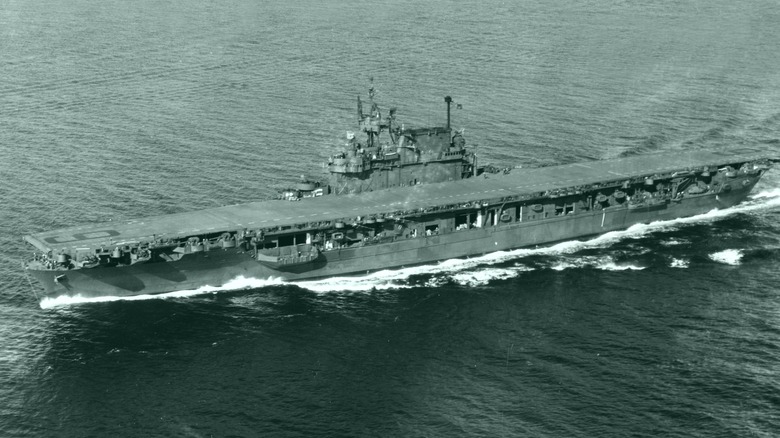5 Of The Most Legendary Aircraft Carriers To Ever Roam The Seven Seas
Aircraft carriers have been around since before World War I, but it took some time before they evolved into the floating islands they are today. Initially, The U.S. Navy's first-ever aircraft carrier could barely launch any aircraft, and was limited by size, speed, and other factors. The battleship ruled the seas throughout much of the first half of the 20th century, but that eventually changed. When World War II kicked off, there were some carriers, but they weren't the primary focus of the world's navies.
That all changed on December 7, 1941, when the Imperial Japanese Navy launched a sneak attack against U.S. forces at Pearl Harbor, Hawaii. That attack took out the U.S. Pacific Fleet of battleships, leaving the aircraft carrier to fill in the gap. From that point forward, carriers' role in the Navy became much more central. There are other nations that operate these massive vessels, but the U.S. is the king, with 11 aircraft carriers sailing the world's oceans as of mid-2024.
Throughout the 20th century, several aircraft carriers made a name for themselves, and not all of them belonged to the United States. Other nations' carriers also fought in various conflicts, and they each did so with distinction. The United Kingdom even considered making an aircraft carrier from ice and wood pulp! These five aircraft carriers are some of the most legendary to ever set sail, and they each have fascinating stories that detail their combat engagements and impact on the history of naval warfare.
The HMS Hermes
The HMS Hermes began construction during World War II, but issues plagued its progress for years. It finally entered active service in late 1959 as the last of the Centaur-class aircraft carriers, though her modifications over the years during construction made the Hermes more akin to newer ships like the HMS Victorious. The Hermes served in various roles for years before seeing proper action, which came during the Falklands War.
The Hermes was set to be decommissioned in 1982, but when the war broke out, she was instead made the flagship of Britain's naval forces participating in the conflict. In this role, the Hermes approached the islands, but remained out of range. The carrier's Hawker Siddeley Harrier GR3s flew from the carrier to keep the Argentinian Air Force at bay throughout the conflict. This made the Hermes one of the most important aircraft carriers of the post-WWII era.
Throughout the Falklands War, the Hermes served with distinction, and she entered into a refit soon after. By 1986, the Hermes had served the United Kingdom to completion, so it was refitted once more and was sold to India the following year. India recommissioned the Hermes as the Viraat in 1987, making her the Indian Navy's flagship. The vessel continued to serve in the Indian Navy for years, becoming the oldest sailing aircraft carrier in the world by the time she was finally decommissioned in 2017.
The Akagi
The Allies weren't the only nations to operate aircraft carriers during World War II. During this time, Japan fielded the Akagi, the first fleet carrier to enter service. Initially, the Akagi was meant to be an Amagi-class battlecruiser, but during its construction, it was refitted into an aircraft carrier, making it the second the Imperial Japanese Navy (IJN) entered into service.
The Akagi wasn't any old aircraft carrier — she was the flagship of the First Air Fleet. She also served as the flagship during the Japanese sneak attack on Pearl Harbor in late 1941. Despite her targets, the Akagi served the IJN well, as the attack succeeded in destroying the United States' Pacific fleet's battleships. However, no U.S. aircraft carriers were sunk at Pearl Harbor because they were elsewhere. After this momentous battle, the Akagi took part in several others, including the Invasion of Rabaul, Australia, the bombing of Darwin, Australia, and more.
The Akagi underwent a refit before sailing with three other aircraft carriers to take part in the Battle of Midway as well. Unfortunately for the Akagi and her crew, Midway proved to be fatal for the famed aircraft carrier. A dive bomber from the USS Enterprise hit the Akagi, damaging it beyond repair. Instead of letting the ship fall into enemy hands, Japanese destroyers on the scene quickly scuttled the Akagi, sending her beneath the waves, though her wreck wasn't found until 2019.
The USS Franklin (CV-13)
The USS Franklin (CV-13) was an Essex-class aircraft carrier built and commissioned during World War II. She entered the conflict relatively late, joining the fight in January 1944, but that didn't keep her out of combat. The Franklin served in several Pacific campaigns, earning four battle stars throughout her service. The reason the Franklin is a legendary aircraft carrier has less to do with her combat prowess than it does with her incredible story of survival.
On March 19, 1945, the Franklin positioned herself within 50 nautical miles of the Japanese mainland, putting her closer than any carrier during the war. Unfortunately, this put the Franklin and her crew at great peril. The crew fought several engagements, but during the evening, while the crew was resting, a single Japanese dive bomber snuck past its radar to drop two bombs on the vessel before her gunnery crews could respond.
One bomb penetrated to the hanger deck, causing widespread fires that should have sunk the ship. It managed to hold on even after the second attack tore through a couple of decks and destroyed the Franklin's aircraft. In the attack 807 died and 487 were wounded. Despite the massive damage and loss of life, the Franklin limped back to safety for repairs, earning the name "The Ship That Wouldn't Die." Ultimately, Captain Gehres was relieved of command, and the Franklin was restored and reclassified before being stricken in '64 and sold for parts in 1966.
The HMS Victorious/USS Robin
The HMS Victorious was an Illustrious-class aircraft carrier built before and commissioned during World War II. She primarily fought in the Battle of the Atlantic, where she met and fought both the battleship Bismarck and her sister ship, the Tirpitz, on several occasions. She also served on several Arctic convoys and aided the island of Malta. After the United States suffered several carrier losses in the Pacific with no fleet carriers in the Atlantic, the British government lent the States the Victorious.
The transfer occurred in late 1942, and while the vessel's name never changed, U.S. Sailors referred to the Victorious as "Robin," so she unofficially became the USS Robin. While under U.S. command, the Victorious received a refit with upgraded aircraft and new equipment. Additional guns, radars, and surveillance equipment were also added to beef up the Victorious for the fight to come.
The Victorious joined the Pacific fleet in 1943 and engaged in combat operations during Operation Cartwheel during the Invasion of New Georgia. She served with distinction and headed back to the U.K. for another refit. It was after this that she engaged the Tirpitz again before returning to the Pacific to fight against the Japanese. Throughout her service, the Victorious lived up to her name, and she finished the war intact. She began another refit, but a fire in 1967 put that to a stop. In 1968, she was decommissioned and then scrapped the following year.
The USS Enterprise (CV-6)
Of all the U.S. aircraft carriers, the USS Enterprise (CV-6) is the most legendary. The Enterprise is the seventh Navy vessel to bear the name and the first aircraft carrier named "Enterprise." Known colloquially as "The Big E," the Enterprise entered active service in 1938 and was one of a few Yorktown-class carriers to survive World War II intact. She's also the vessel that inspired Gene Roddenberry to name his starship the Enterprise in "Star Trek," so The Big E has a lasting legacy.
During the war, the Enterprise took part in more actions against Japan than any other vessel in the U.S. fleet. She wasn't at Pearl Harbor at the onset of the attack, but she arrived to take part in the defense of the harbor. The Enterprise then took part in the Battle of Midway and other important conflicts in the Pacific Theater during WWII. Throughout it all, she served admirably, earning an astounding 20 battle stars — the most for any U.S. vessel during the war.
Throughout WWII, the Enterprise's bombers sank 71 enemy ships, her planes shot down 911 enemy aircraft, and she damaged or destroyed an additional 192 ships. That's not a record that's easily matched, and so far, no U.S. vessel has come close. The Big E is not only the most decorated U.S. warship of WWII, but she is also the most decorated aircraft carrier in U.S. history and will likely retain that honorable distinction for many years to come.
